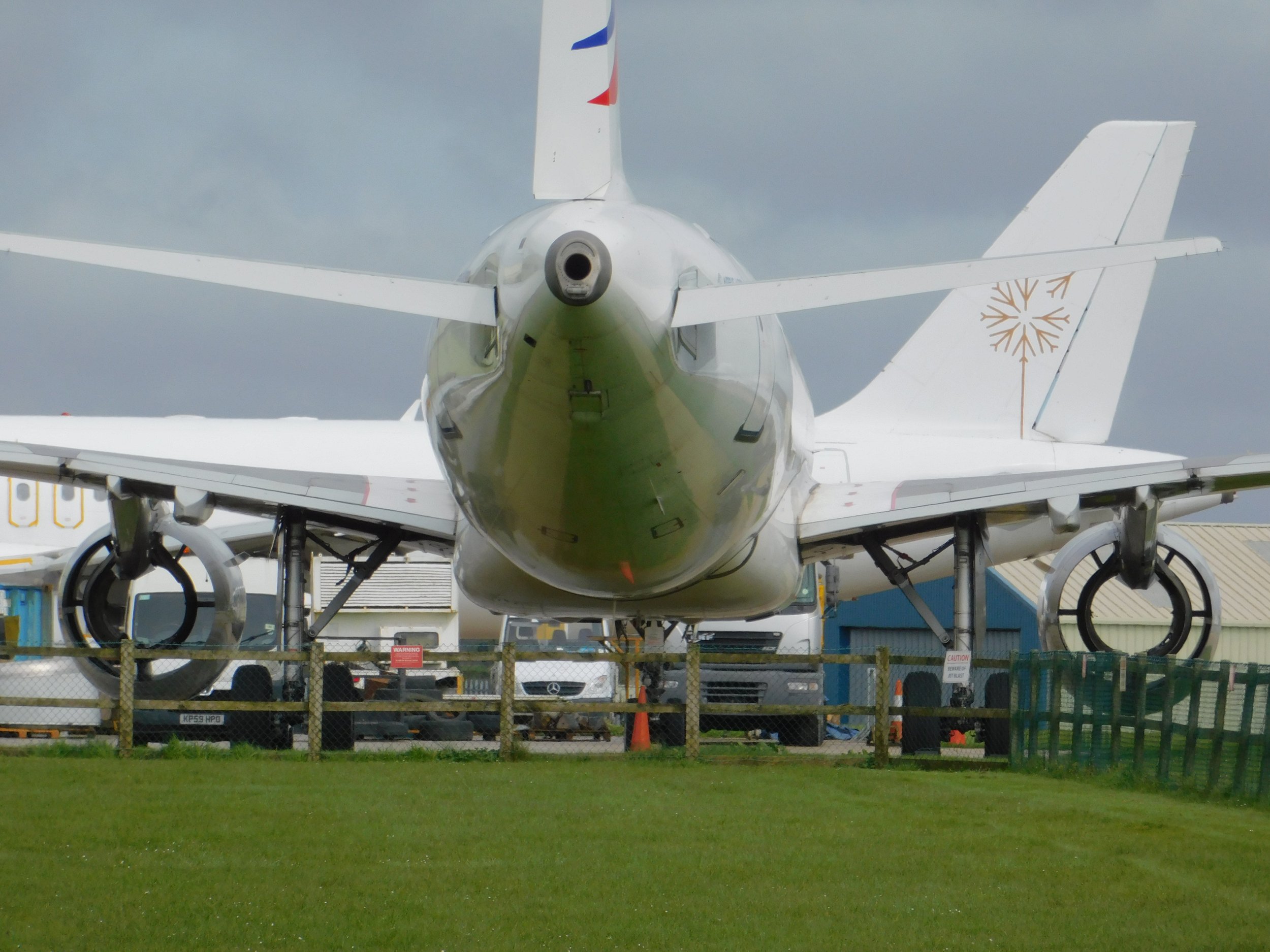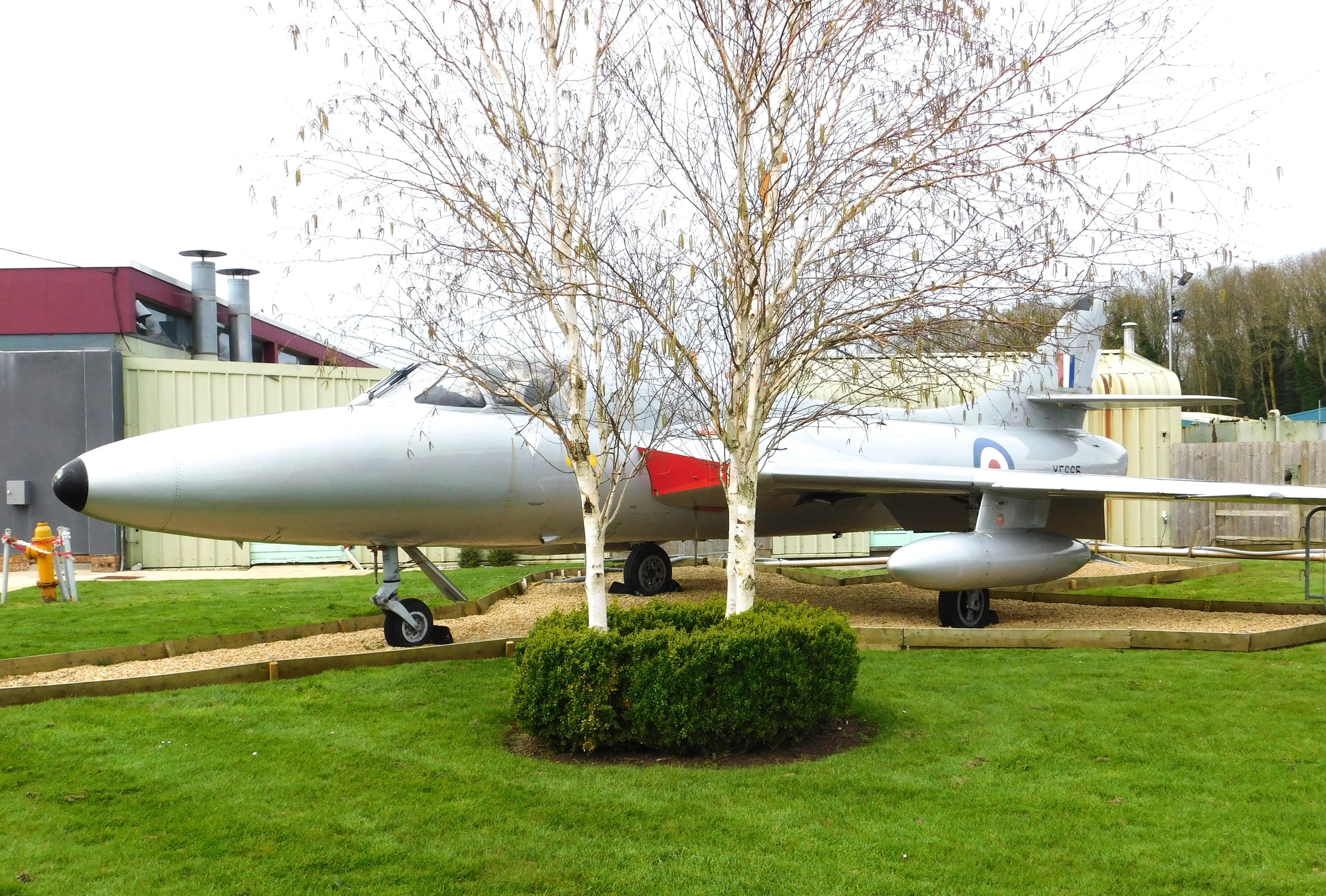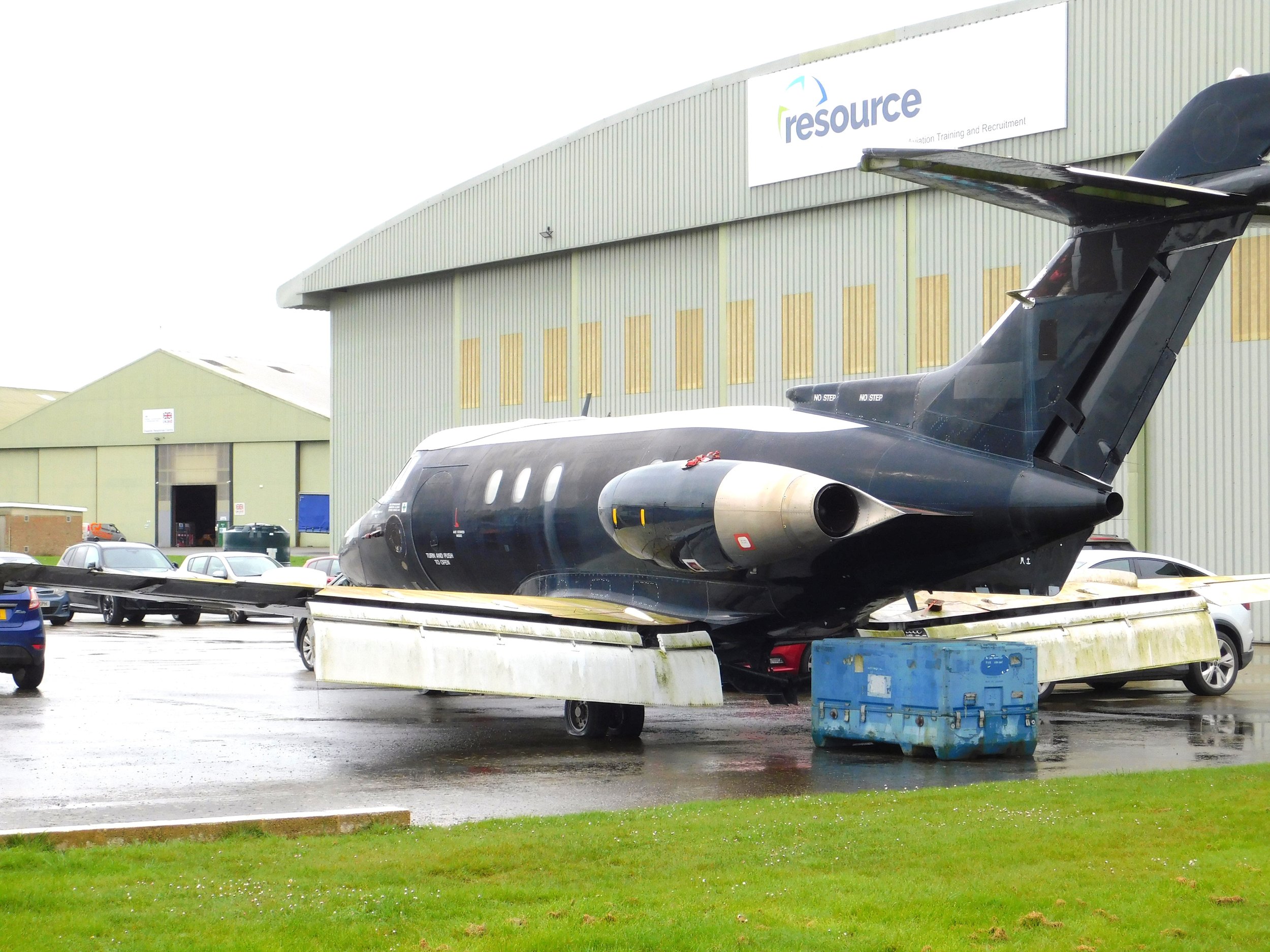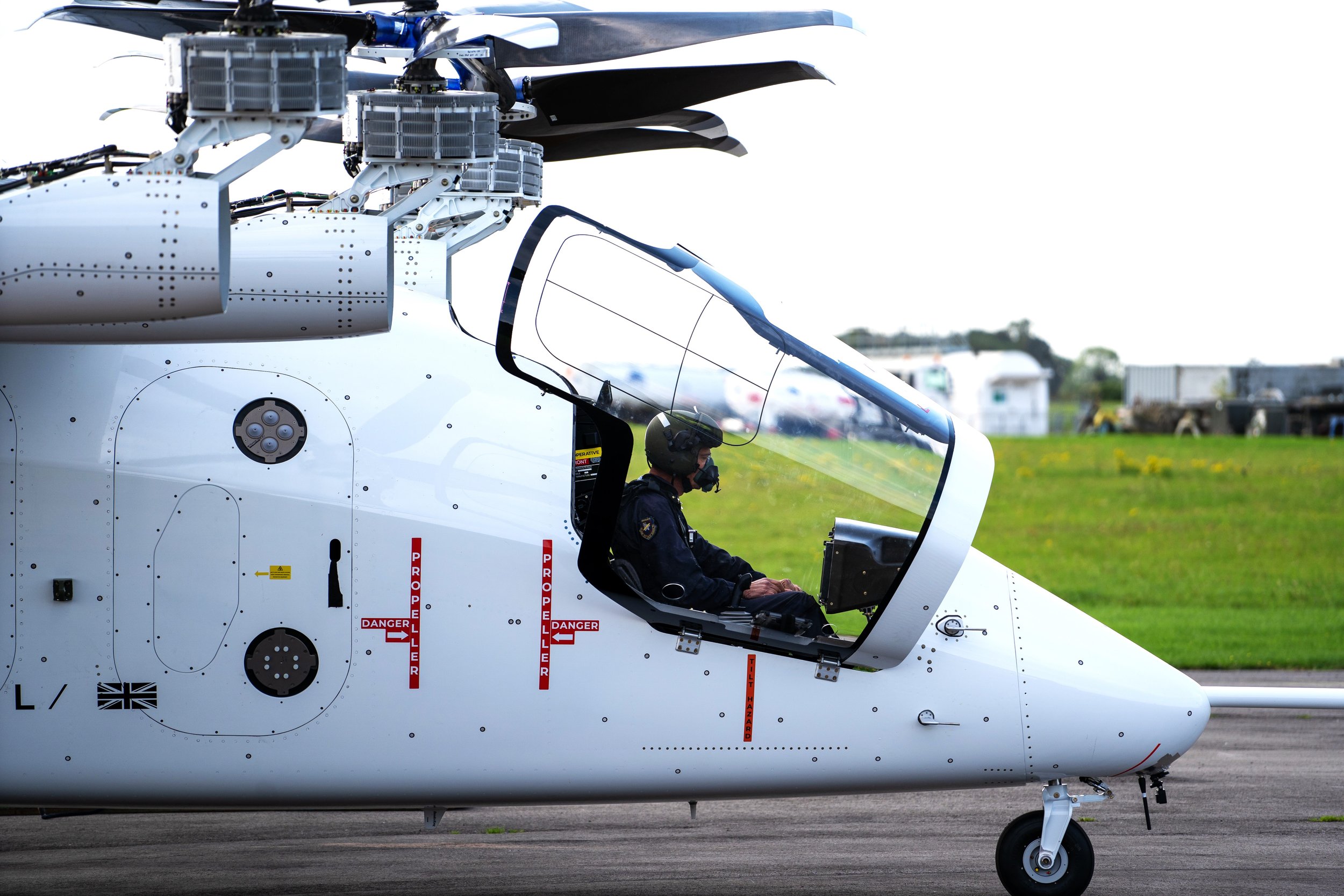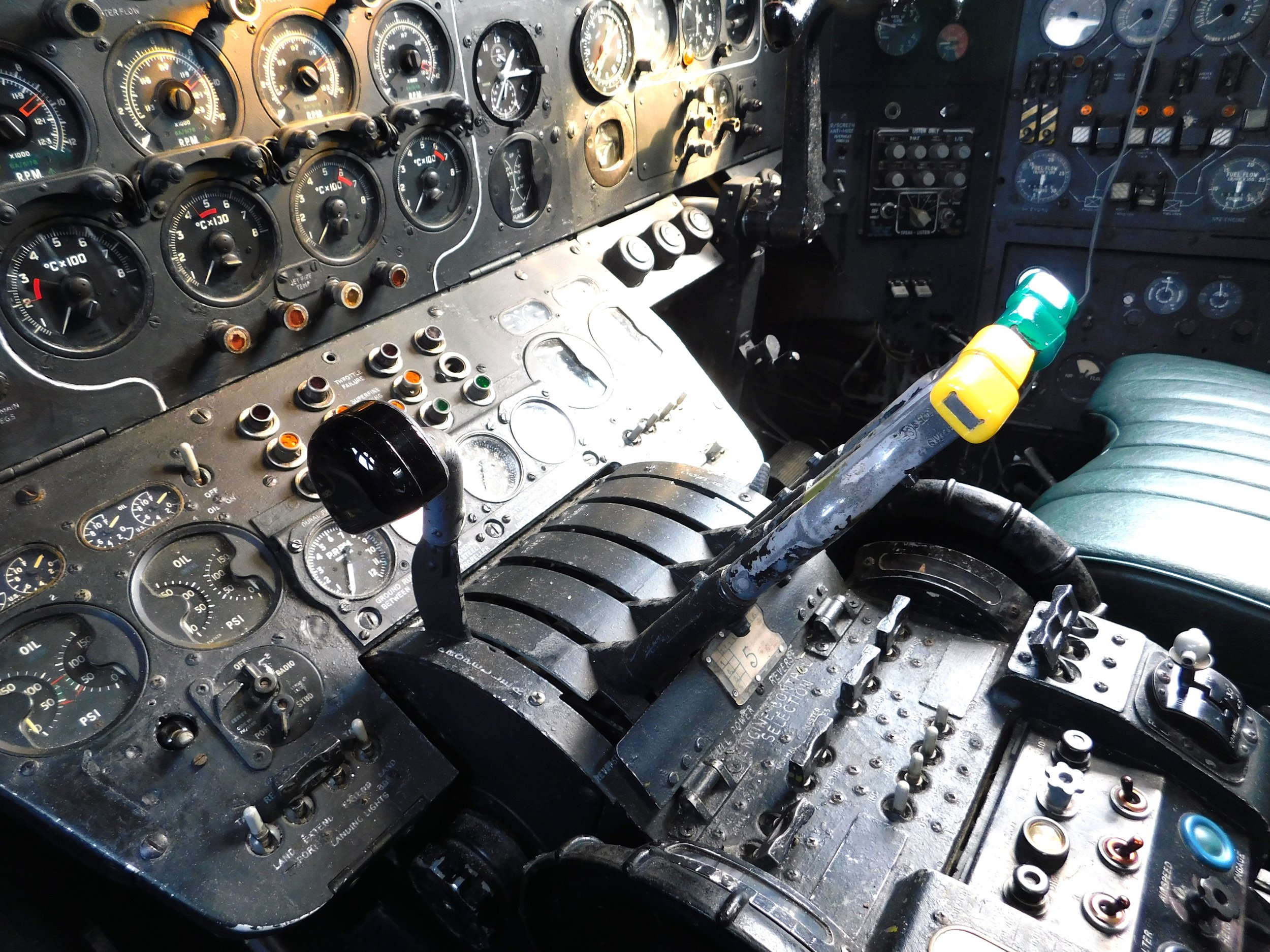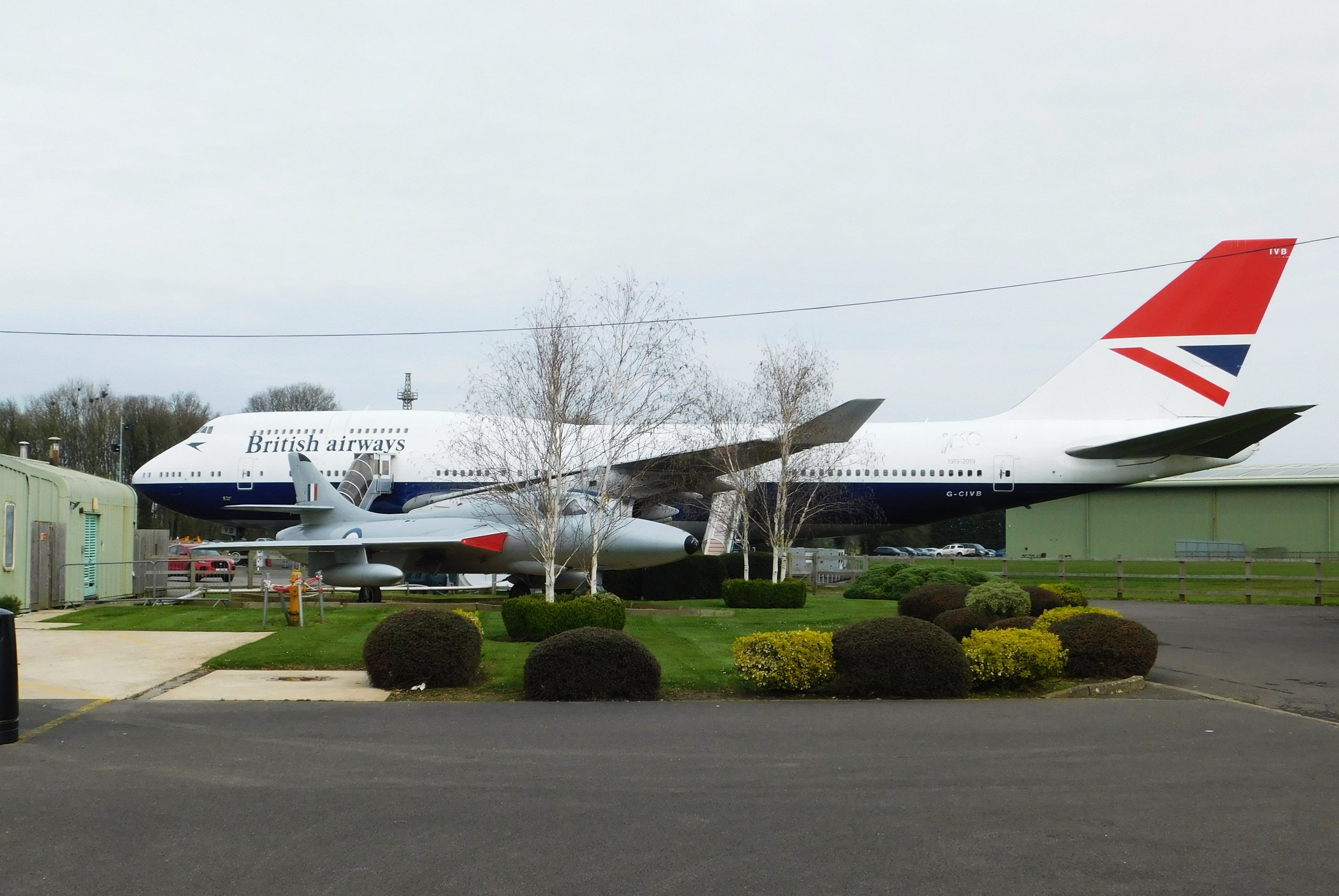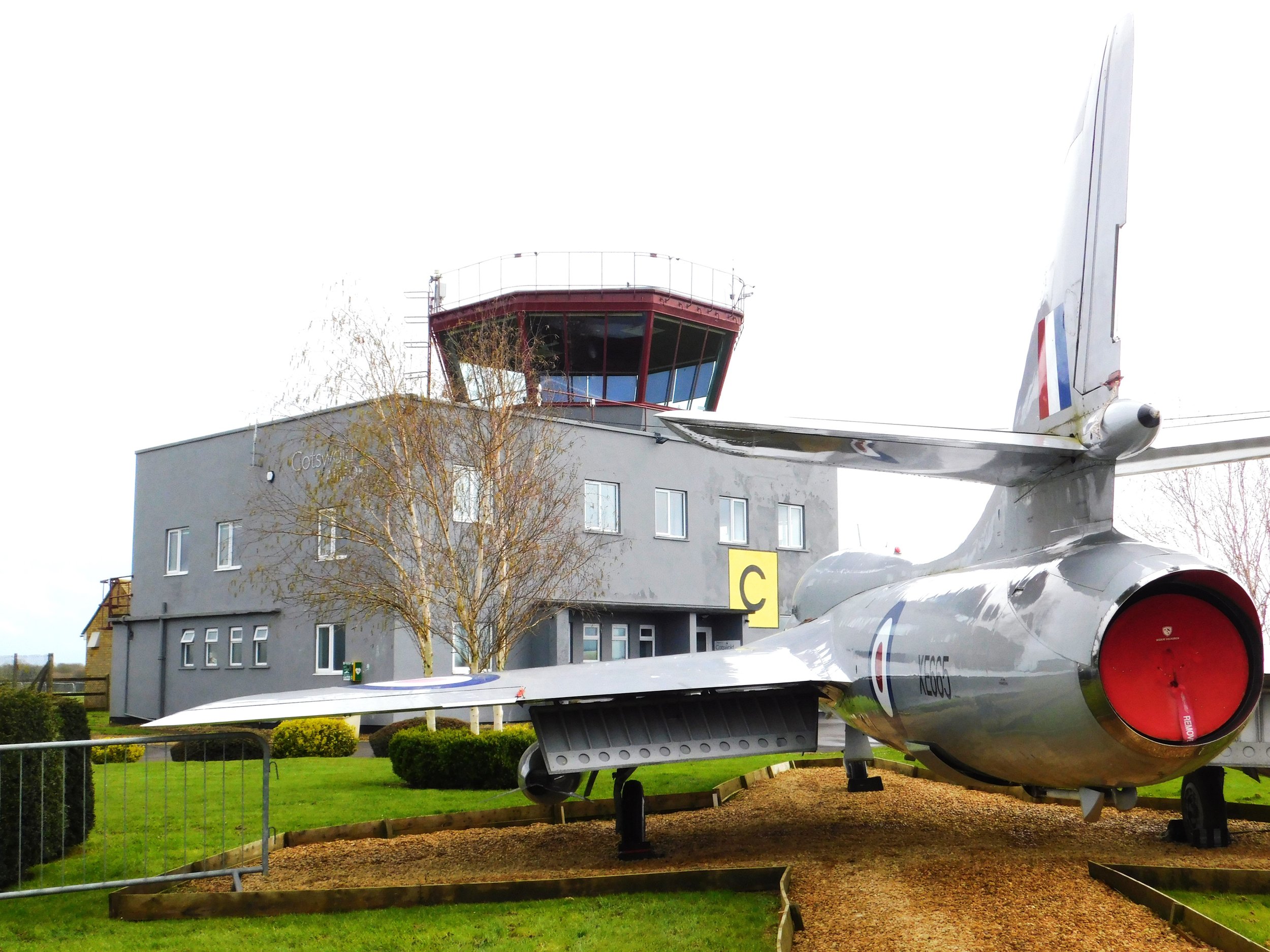Cotswold Airport
Issue 49, a visit to Cotswold Airport Cirencester, UK Oct 2024
On 14 October 1997, a large and stately four-engine Bristol Britannia approached Cotswold Airport with a Hawker Hunter escort on its left wing. As the turboprop powered transport made a tight right turn to line up with runway 27, spectators could see that the landing gear was still up. Flying at over 200 knots, the Britannia made a low pass just feet above the runway. A tight turn to the right brought the transport plane back around for another low pass- this time momentarily disappearing below the horizon. The Hawker Hunter chase plane landed first, complete with a drag chute. Next, the Bristol Britannia XM496, named “Regulus”, landed to complete the last flight ever of a Bristol Britannia. She is now proudly on display at Cotswold Airport in the West of England.
Originally opened in 1936 as Royal Air Force (RAF) Kemble, the base served as a maintenance and transportation hub. It was the home of the Air Transport Auxiliary, providing ferry flights throughout the UK and No. 1 Overseas Aircraft Preparation Unit (OAPU) for international flights. It mainly served in these roles during World War II and throughout the cold war. Later, the US Air Force used RAF Kemble as a maintenance facility, servicing A-10s, F-5s, F-15s, C-130s, and KC-135s.
The US Air Force left Kemble in early 1992, followed by the RAF later that year. The Ministry of Defense (MoD) continued to use the base for storage until the airport was sold to a private operator in 2001.
Cotswold Airport has gone through several transitions since the RAF left, including efforts to have the airport closed. The site was called Kemble Airport until 2009, when the name Cotswold Airport was adopted. Today the airport has a CAA Ordinary License (Number P863), which allows flights for the public transport of passengers or for flying instruction as authorized by the licensee (Kemble Air Services).
As you enter the field, you immediately see the RAF heritage. Travelling to various parts of the airport, you will notice buildings that were obviously former military buildings of RAF Kemble, many of them dating from WWII and earlier.
There are several areas where you will see airliners in various stages of repair or disassembly.
You will also see various airliner types here for heavy maintenance, restoration, or perhaps dismantling. This is, in some respects, like airports in the American Southwest that specialize in airliner storage and restoration.
Of course, the airport is not a museum and, while maintaining a home to display historic aircraft, Cotswold is clearly embracing the future of aviation. Based here are companies developing electric powered aircraft as well as hydrogen- electric powerplants (more about that later). The airport is also a growing general aviation airport and describes itself this way on the website-
“Cotswold Airport is a charming general aviation airport located in the heart of the Cotswolds, an area of outstanding natural beauty in England. We offer a warm welcome to all pilots and passengers, whether you're just stopping for a quick refuel or planning to stay a while and explore the beautiful surrounding area.
Cotswold Airport is the largest private business aviation airport in the UK's South West, with the longest runways and new RNP Instrument Approaches. It has easy links to the major road and rail networks.” Many thanks to Will McIntyre for information about the airport!
But my visit was to discover the historic aspect of the airport, so let’s continue.
In the later years of RAF Kemble, it was best known as the home of the Royal Air Force demonstration team, the Red Arrows. The Red Arrows were based at Kemble from 1966, right after their inception, to 1992, when the base closed. During most of that time, they flew the Folland Gnat, and a Gnat is proudly on display in front of the Cotswold tower
The Gnat was chosen by the RAF for the Red Arrows because it was the advanced jet trainer at the time, making it convenient and cost-effective. In 1979, the newer RAF trainer, the Hawker Siddeley Hawk, replaced the Gnat. Today, the Red Arrows continue to fly the Hawk (now a BAE Systems product) and are based at RAF Waddington.
First flown in 1955, the Folland Gnat saw service from 1959 until 1979, with 449 built. Originally designed as a light fighter, the RAF only operated the Gnat as a trainer, although the type did serve as an operational fighter for several other countries.
The little-known Folland Aircraft company was founded by Henry Folland in 1937. Folland had been chief designer at Gloster Aircraft and he took over a former seaplane facility at Hamble, near the Isle of Wight, to start his own company. The only aircraft produced by Folland were the Midge, also a light trainer, and the Gnat. In 1959 the company was taken over by Hawker-Siddeley, which eventually became part of British Aerospace (BAE).
The Folland Gnat on display at Cotswold Airport is Gnat T1 XP502 but it is painted as XR540, which flew with the Red Arrows.
Displayed nearby the Gnat is this Hawker Hunter, XE-665. This plane had a varied history while active and has also moved around a lot since being retired in 1995. Built in 1955 as a Hawker Hunter F4, a single seat fighter, it originally served with the RAF in Germany. In 1958 it was converted to a T8, a two-seat trainer for the Royal Navy, complete with tail hook. Her first assignment in that role was with 764 Naval Air Squadron at RNAS Lossiemouth in Scotland. She also spent time based at three other military bases.
Upon retirement in 1995, XE-665 was acquired by the Hunter Flying Club in Exeter, with the hopes of keeping her flying. Unable to get funding, the Hunter then moved to Delta Jets at Kemble (Cotswold) Airport. Delta Jets collapsed in the early 2000s and XE-665 has gone through several custodial situations since. Today she is looked after by The Buccaneer Aviation Group and is displayed between the tower and the AV8 café.
The Hawker Hunter first flew in 1951 and entered service in 1954. In various countries around the world, Hawker Hunters served well into the 21st Century. In 1953, a modified prototype broke the world airspeed record at 727.63 MPH. The transonic, swept-winged interceptor was powered by a single Rolls-Royce Avon turbojet and a total of 1,972 were built. In the 1960s, Hunters were used in fighter-bomber roles and for aerial reconnaissance. Several of the RAF demonstration teams that preceded the Red Arrows flew the Hawker Hunter.
RAF Black Arrows Demonstration team photo: Arpingstone, Public Domain
Founded in 1956, the Black Arrows demonstration team once looped 22 Hawker Hunters in formation. That 1958 event still stands as the record today.
The airport’s AV8 Café, with indoor and outdoor seating, is a popular luncheon spot. When visiting England, I used to take my Aunt Peg on outings and she always enjoyed a day out, and a lunch, at Cotswold Airport. Weather permitting, we would sit outside, but inside was also pleasant, with airline seating available.
Dominating the area near the tower is this Boeing 747-400, G-CIVB. It was one of three 747-400s that British Airways painted in retro livery, in this case, the “Negus“ livery from the 1970s. It was the last of the three retro aircraft to retire from BA, leaving Heathrow to fly to Cotswold Airport on 8 October 2020.
The interior of Negus is open to visitors on most Wednesdays and Saturdays and there is an on-line reservation system. Once inside the huge plane, you see the front end preserved just as it was in British Airways service.
On the upper deck, the business class seats are still in place and the cockpit remains exactly as it was for its final passenger flight. Because it is a “glass” cockpit, you just see blank screens, as the plane is unpowered. On certain days, cockpit tours are offered, and I assume that includes powering up the instruments.
Even unpowered, it is interesting to see a 747 cockpit in preserved original condition.
In the early 1980s, Boeing introduced the 757/767 series, the first large airliners designed with a glass cockpit and a crew complement of two rather than three (the 767 and 757 were certified for two pilots late in the certification process and they have the remnants of a flight engineer station that was never needed). After the introduction of the 767, sales of the 747 slumped and Boeing began work on a 747 upgrade. The 747-400 was introduced in 1988, offering a glass cockpit and a two-pilot crew. The 747-400 cockpit looks very much like the 757/767 cockpit.
Although it is always great to see an aircraft being preserved, especially in a retro paint scheme such as this, I must admit that I was a little disappointed at my visit. After paying £12.50 (approximately $16.75) I found that there are not a lot of interesting items to see inside the 747, at least from an aviation history standpoint. There was very little done to present the history of this plane or the 747 and British Airways in general. All there is to do is to walk through the front half of the plane.
Upper Galley
To be fair, the plane’s main use now is for an event center and, if that is what it takes to maintain this historic plane, so be it. It is a relatively new display, so hopefully a little more attention will be paid to the history of the aircraft in the future. The company told me that there are some plans in the works.
On the positive side, the events center, in the aft of the plane, looks like a great and unique venue. In scrolling through the website, it looks like visiting during the Christmas season would be a lot of fun.
Photo courtesy of Negus
Photo courtesy of Negus
For regular tours or special events, visit the Negus website https://www.negus747.com/
Photo- Richard Paver
Although not on public display, this Spitfire, MT818, is available for flights at Cotswold Airport. Built as a type 359 Spitfire F Mk. VIII in 1944, it is the only prototype Spitfire in existence. The plane was later converted by Vickers to a two-seat trainer, Type 502. MT818 was used as a demonstrator as well as participating in air races and handling trials. The plane was sold to a civilian owner in 1956 and has passed through many owners since, including several in the US. It returned to the UK in 2007 and underwent restoration at Kemble (Cotswold).
Clearly visible in the photo above is the 747 with the tower off its left wing, and then the little red Gnat. Just below the Spitfire engine, the Britannia is clearly visible. In the distance you see the scenic Cotswold Hills.
Photo- Richard Paver
Off the nose of the Spitfire in this shot, is a group of airliners ready for maintenance or refurbishing.
Fly a Spitfire has three Spitfires and a P-51 and several flight opportunities are available. You can find full information at https://flyaspitfire.com/spitfire-flights-cotswold-airport/
Near the Britannia is this interestingly shaped portable hangar. It is home to the British Phantom Aviation Group (BPAG), with two McDonnell Douglas F-4 Phantoms under restoration. The planes are specific to British operations of the Phantom, one with the Royal Air Force and one with the Royal Navy’s Fleet Air Arm.
The British Phantom Aviation Group (BPAG) owns a total of five Phantoms. Their histories are very interesting, but too extensive to cover here. The website does a great job of describing each of the five Phantoms. https://bpag.co.uk/
BPAG began as a Facebook group in 2012, dedicated to the UK specific F-4s.
In 2013, BPAG decided to go beyond a Facebook group and began investigating acquiring actual aircraft. The many contacts made from social media were utilized in this endeavor and, as above, I am going to leave it to the Group’s excellent website to tell the story of how the aircraft were acquired.
Among other goals, BPAG plans:
“*To collect and archive, in all formats, media relating to the history of both the K and M variants as well as J model F-4 Phantoms in service in the U.K.
*Acquisition of an at least one example airframe of each type of British F-4 Phantom.
*To share and preserve all existing mechanical skills, provide technical support and advice, and offer training to a new generation of engineers interested in STEMS, modern and general aviation, and heritage jets. The British Phantom Aviation Group believes that the minds of the future can benefit greatly from the knowledge of the past.”
Seeing the F-4s in pre-restoration condition really gives an appreciation of what it takes to preserve historic aircraft.
In Issue 47, about the Fleet Air Arm Museum, we discussed the many changes made to the F-4 for the UK to acquire the Phantom II. Some of the differences were stated this way-
“In the 1960s, the Royal Navy needed a new fighter to replace the aging Sea Vixen. With costs of aircraft development soaring, the Fleet Air Arm (and the RAF) looked to acquire existing aircraft- such as the McDonnell Douglas Phantom II. The decision was made to acquire the Phantom II, which would be powered by Rolls-Royce Spey engines rather than the original General Electric J79. The reason for the engine change was two-fold. British carriers were smaller than U.S. carriers, and the increased thrust of the Rolls-Royce engine would aid in catapult shots. In addition, the change would allow a major portion of the Phantoms to be built in Britain. The aft fuselage had to be re-designed to accommodate the larger Spey engines, which resulted in even more local work. The Fleet Air Arm aircraft were developed from the F-4J model and were designated the F-4K. The RAF version, which was similar to the Fleet Air Arm (FAA) version, was designated the F-4M”.
Since my visit to Cotswold Airport, The British Phantom Aviation Group has moved a third F-4 to Cotswold.
Photo Courtesy of BPAG
When I visited Cotswold, I was kindly given a private tour of the restoration hangar by Andy Bowen. I asked Tony Clay, PBAG secretary, about public access to see these historic planes. He sent this information-
“We recently held our first public open day, which was a huge success. With winter approaching we will be holding more next year starting in the Spring. The immediate plans are to continue with the aircraft restoration on all three airframes so that we can carry on showing progress to our supporters in the Spring for the next open day. We usually average 2 to 3 weekends a month at present for work party volunteers. At the beginning of each month we advertise the work party dates to our dedicated volunteers and our members in general and anyone can reach out to assist. You don`t have to be an engineer to help, volunteers with no aircraft experience would be shown how to complete a task by one of the experienced members. When we have these work party weekends we often receive visitors who can look around providing there are no health and safety issues to consider. It`s just a case of if we are there, feel free to pop in.
The long range plan is the establishment of a UK Phantom Heritage Centre at Cotswold Airport.” Thanks Tony!
The Hawker Siddeley Aviation 125 has a long and varied history. It was originally a de Havilland design, designated the DH 125 Jet Dragon. First flown in 1962, it was originally manufactured by Hawker Siddeley until 1977 (HS 125). It was taken over by British Aerospace (BAE) until 1993, by Raytheon until 2007, and finally, as a Hawker Beechcraft product until 2013. A total of 1,720 were built during the fifty-year production run. Designed as a mid-sized business jet, the Hawker also served in military applications such as the Hawker Siddeley T1, an RAF navigation trainer. It was operated by the United States Air Force as a calibration aircraft, the C-29A.
The training organization Resource Group has five Hawker Siddeley Aviation 125 Dominie T1 aircraft based at the Cotswold Airport and at Humberside airport. These aircraft were previously operated by the Royal Air Force as navigation trainers. (one of them was recently moved to become an Airbnb).
This Hawker, serial number 25050, was used as a six-person navigation trainer, based at RAF Cranwell until 2011. The training positions remain in place. Photo courtesy of Resource Group.
Resource is deploying the planes, in non-flying condition, for a variety of maintenance training applications. Each airframe is maintained at a certain level to provide maintenance training including apprentice training, procedures trainers, systems trainers, and a fully functional towing and taxi trainer. At any time you visit, you might see a Hawker at the fence, just past the Britannia and F-4 hangar.
For more information about Resource Group, see their website- https://training.resourcegroup.co.uk/ Thanks to Jessica Smith for providing information about the Hawkers!
Looking at present day Cotswold Airport, there are several businesses on the field, such as ZeroAvia and Vertical Aerospace, which clearly look to the future.
Photo courtesy of Vertical Aerospace
Headquartered in London and Bristol, Vertical Aerospace is developing an all-electric air taxi that is being tested at Cotswold Airport. They recently (September 2024) tested their aircraft in tethered flight with a pilot on board.
Photo courtesy of Vertical Aerospace
ZeroAvia is a British/US company located at Cotswold and at Hollister airport in California. ZeroAvia is developing hydrogen/electric aircraft engines and they are well on the way to producing two engines- one suitable for 10-20 seat regional aircraft and one suitable for 40-80 seat regional aircraft.
I had noticed from a distance these Blackburn Buccaneers. The aircraft are owned by The Buccaneer Aviation Group (TBAG) and I contacted Francis Wallace, Chairman of the group. He provided this information-
“ We have in our collection three Blackburn Buccaneer S.Mk.2 aircraft. XX894, XW544 & XW550. Unfortunately our aircraft are located on the active site of the airport therefore, to see the Buccaneers up close is by prior appointment or during one of our many events throughout the year. The Buccaneers can however be glimpsed from the G-Site security gate or they can be viewed from the airport's brilliant AV8 restaurant. Our Buccaneer cockpit section XW550 can often be found on display outside the AV8 restaurant as well.
Enquiries for visiting us can be made at our email address: thebuccaneeraviationgroup2020@gmail.com
All events are listed on our website and are promoted through our social media page:
https://the-buccaneer-aviation-group.com/events/
https://www.facebook.com/TbagCotswoldAirport.
Francis added a little about the three Buccaneers:
“XX894 first flew in December 1975 and made its last flight 19 years later in April 1994 with 4720 flying hours. XX894 was one of 12 Buccaneers deployed to the Gulf in 1991 and is credited with destroying an AN12 Cub whilst it was taxiing at Shayka Mazhar Airfield.
XW544 first flew in 1972 and made its last flight 11 years later in 1983 having amassed 2227 flying hours. XW544 had a relatively short flying career due mostly to being plagued by fuel tank leaks, an issue that the airframe still occasionally suffers from in preservation!
XW550 first flew in 1973 and retired only 7 years later, in 1980, with 1925 flying hours. Upon retirement many parts were removed and returned to service leaving the remains of the airframe not much more than a gutted shell. XW550 was eventually cut up for scrap but the cockpit section was saved which we acquired in 2016. XW550 was fully restored over the next 2.5 years and was mounted to a trailer becoming a travelling exhibit to raise awareness and funds for XX894 and XW544.” Many thanks Francis!
Alongside the Buccaneers is this English Electric Canberra which is owned by the airport and is likely to be put on display in the near future. It is maintained by The Buccaneer Aviation Group.
Returning to the Britannia from the opening story, we find the most fully developed aircraft display at Cotswold. The inside is open to the public on alternate Saturdays (free admission). On other days, it is still interesting to walk around the aircraft and on any day, you may see volunteers working on the historic plane.
Inside you will find an elegant combination of the preservation of the plane in operational condition and a variety of displays about Regulus, and the Britannia in general.
The cockpit is preserved in the exact condition it was in for that memorable 1997 final flight.
As a complex four-engine aircraft, the Britannia required a large crew to operate it. The various operational stations of the Britannia are well preserved and a very detailed illustration is on display to point out the purpose of each area of the plane.
Half of the interior is preserved as Regulus was during RAF passenger service.
During WWII, the British government realized that they would have to be pro-active about the design and production of post-war aircraft that would be necessary to maintain logistics in the wide-spread British Empire. In 1942, the Brabazon Committee was set up to study the issue. The Committee came up with a list of five general types of air transports that would be required:
Type I: a very large, long-range landplane for the North Atlantic route.
Type II: an economical replacement for the Douglas DC-3 for European services.
Type III: a four-engine, medium-range landplane for the Empire routes.
Type IV: the most advanced of them all, a jet-propelled mailplane for the North Atlantic.
Type V: a twin-engine, fourteen-passenger feederliner.
Several designs were proposed for each category, with mixed results. For Type III, the Bristol Aeroplane Company finalized, in 1947, their proposal of a Centaurus-powered design with a gross weight of 103,000 lb and a payload of 13,300 lb. On 5 July 1949, the Ministry of Supply ordered five such prototypes with the understanding that British Overseas Airways (BOAC) would contract for 25 production units. BOAC purchased options for 25 aircraft on 28 July. By 1950, the name Britannia had been selected and two prototypes were under construction.
Following various delays, the first prototype flew on 16 August 1952 at Filton Aerodrome. After three de Havilland Comets (Type IV) crashed in 1953 and 1954, the Britannia was ordered to undergo additional testing. Encountering a number of engine and other issues during testing, the Britannia did not become operational until 1957, ten years after the original design was proposed. Many international airlines had been interested in the Britannia, including TWA and Eastern. In 1950, the performance of the Britannia would have been dominant for airlines. By 1957, however, the Boeing 707 and Douglas DC-8 were becoming available and, in the end, BOAC was the only major civilian customer. Just 85 of the type were built from 1952-1960. Other operators included the RAF, Canadian Pacific Airlines, and Cubana.
Regulus was originally purchased for the RAF as a model 253, of which 20 were built. As an RAF transport, Britannias were assigned to Number 99 and number 511 transport squadrons. These squadrons operated the Britannia from RAF Lynham from 1959 to 1970 and from RAF Brize Norton, 1970 to 1976, when the Britannia was withdrawn. The two squadrons operated a pool of aircraft and so Regulus served with both squadrons. RAF Britannia operations, including several accidents, are well documented in photos and descriptions throughout the plane.
Once released from the RAF, Britannias found themselves in commercial service throughout the world. This part of the history of Regulus and other Britannias is also well documented in the aircraft displays,
If you visit Cotswold airport, I highly recommend being there on a Regulus open house day- it is a very interesting exhibit. You can find a lot more information about Regulus on their website. https://xm496.com/
Here is a link to a film of that amazing final landing of the Britannia. https://xm496.com/restoration-of-the-xm496-regulus/
Many thanks to Jim Brown for lots of information.
----------------------------------------------
Obviously a whole airport was a bit of a stretch to include in a blog about aviation museums- but the Cotswolds are a great place to visit and any aviation buff would enjoy roaming around the airport, seeing the various aircraft on display and having lunch in the AV8 cafe. The airport operator is to be commended for maintaining the historic parts of the RAF base, while still looking to the future.
I mentioned my aunt Peg earlier and the Cotswolds are near and dear to me as my mother, Nella, was from the village of Nailsworth, not far from Kemble. She met my father while she was teaching in London during WWII.
-------------------------------
Because most of the displays are independent of each other, I corresponded with numerous people while writing the blog. I will say that all were very responsive to my inquiries, which is not always the case when I write about museums in the US.
A special thanks to all who offered to help with information!
As always- feel free to share or post this blog.
--------------------------------
Updating last week’s blog about the supply missions for hurricane Helene relief being organized by local museums:
The Military Aviation Museum (MAM) in Virginia Beach is doing their share by channeling WWII supply efforts. Here is their recent email about the effort-
Hurricane Relief Supply Flights
Thank you to everyone who has supported the airlift from the Museum so far! Everyone here was absolutely overwhelmed by the volume of supplies that were brought out to the Museum during the air show. As some of you who have followed the Museum’s social media channels know, the C-47 “Chalk 40” flew 5,000lbs of supplies to Lincoln County North Carolina on Sunday at the conclusion of the show. These supplies were donated by our community, and loaded by air show attendees. An absolutely amazing sight to behold.
Loading of the DC-3 "Western Airlines" - Photos by MC2 Megan Wollam
With the departure of “Chalk 40” however, we realized we had about 3 additional loads of supplies gathered. Working with Tim and Job Savage of Vintage Flying Machines, we were able to make arrangements for their DC-3 “Western Airlines” to take up the work of flying supplies into the areas hit by Hurricane Helene. “Western Airlines” was flown out of its home base in Florida, in the path of Hurricane Milton by a joint crew from the Military Aviation Museum and Vintage Flying Machines, and is now basing at the Museum campus in Virginia Beach.
On Tuesday, Sailors from NAS Oceana loaded the DC-3 and they quickly turned around and flew another 5,000 lbs. of supplies to Winston-Salem, to be further transported by smaller aircraft and vehicles into the hard-hit areas.
Today, Johnson County Airport in Mountain City, Tennessee, reached out to us with a plea for a flight of supplies. They are outside of the areas making the news and are in serious need of help. It’s starting to get cold in the mountains, and they need camping gear and items to keep warm as they work to salvage what’s left and rebuild their community. We are committed to flying them the supplies they need! We are planning a flight that will leave mid-morning on Thursday, October 10th.”
Cash donations are also being accepted by the Museum to offset the costs of fueling the aircraft for the mission. Donating here will support the missions-
https://www.militaryaviationmuseum.org/donate/
An update to last week’s blog from Bill Baker-
“Hickory Aviation Museum Update for 10/9/24:
1. As of 6pm last night, aerial relief operations have ended flying out of Hickory Regional Airport. HKY is now back functioning as a fully operational airfield. There is no longer any relief call center, relief flights, nor is the airport a location to drop off supplies, it's back to business.
2. The Museum staff today will be putting everything back where it is supposed to be, cleaning, ensuring the temporary phone lines are removed etc. and so on and we will be back open tomorrow, Thursday, 10am and resuming our normal days and hours of operations.
3. According to Jeff Wofford, Museum President, who assisted HKY in flight safety ops, there were over 2,500 missions launched bringing in untold thousands of pounds of relief supplies and rescuing over 150 victims of Helene in Western North Carolina. That is both civilian and military. A group of 82nd Airborne Army Special Forces dropped into areas to conduct search and rescue and these troops did not wait for orders, they all took personal leave time to assist. Jeff said, "This has been one of the most amazing things I have ever seen."
4. Shout out to Museum General Manager Buford Barnett who organized the HAM volunteers and made sure everything went as well as it could liaising with the relief coordinators, he put in more hours day and night than everyone and I'm sure he'll take a few days off to decompress. We'd give him a pay raise, but even if we tripled $0.00, it's still $0.00!
5. Shout out to HAM volunteers who put in their time when asked, many having sustained damage themselves at their homes and neighborhoods.”
Thanks again Bill, and kudos to all the volunteers who helped hurricane relief and who are probably still helping!
--------------------------------------------
To learn about museum hours and costs as well as books to read and other interesting odds and ends, keep reading! At the end you will find a photo gallery of the entire airport.
PLANNING YOUR VISIT
Located in the scenic Cotswold Hills in the West of England, the airport is easily added to a tour of that beautiful and historic area. There are many attractions in the area, including Oxford, Stonehenge, and Cotswold Wildlife Park and Gardens. There are also many scenic villages in the area including Castle Coombe, Burton-on-the-Water (with a motoring museum) and Painswick, among many others. The airport is less than a three-hour drive from London, making a day trip possible. It is two hours from the Fleet Air Arm Museum visited in Issue 46 and 47. As a public airport, you can drive around any time and see these aircraft- but individual tour times are limited- check each website for details.
FLYING IN
Cotswold Airport (EGBP) is a full service airport with a long runway 26/08 (big enough for a 747) and there is an RNAV (RNP) approach to each runway. The airport is PPR by phone and hours are limited, so be sure to contact airport operations before planning a visit. Customs are available, but with advanced notice.
AIRPORT WEBSITE (history section)
https://cotswoldairport.com/airport-history-heritage/
As noted in segments of the blog, each heritage group on the airport has its own website- each containing a wealth of information. Taken together, the websites have more information available than even the most complete aviation museum website.
WRIGHT BROTHERS STORIES
My friend Chip Walton is a retired airline pilot and among his many activities here on the Outer Banks, he is a volunteer docent at the Wright Brothers Memorial. Chip’s presentation are always excellent and I asked him to write something for this segment.
“As pioneers in Applied Aerodynamic Engineering, the Wright Brothers redefined our understanding of what makes an airplane fly. This is one aspect of their legacy where they don’t get nearly enough credit. One can argue that the results of their wind tunnel testing in late 1901 accounted for the exponential growth in aviation after 1910.
To understand the brother’s contribution to aerodynamics, let’s review how we define the lift force. Lifting force is represented by a simple algebraic equation. After 1909 we define lift as:
Lift=1/2 ρ x V2 x A x Cl, where
1/2 ρ (rho) is air density, affected by altitude, temperature, and humidity;
V2 is the square of the velocity of the wing;
A is the surface area of the wing of the aircraft; and,
Cl is the coefficient of lift which is a complicated term for a simple concept. Coefficient is another word for constant. Measured in a wind tunnel, it is simply how different cambered, or curved, airfoils perform as they are presented at different angles to the wind. Influenced by air viscosity and compressibility, how much lift and drag does a wing produce at different angles of attack
According to John D Anderson in A History of Aerodynamics, before 1909, the lift equation was slightly different. In lieu of 1/2 Rho, the few engineers interested in flight used a pressure constant called “Smeaton’s Coefficient” which was the drag on one square foot of plate against one mile an hour wind. Instead of wind tunnels, large whirling arms of up to 23 feet in diameter were used to try to measure lift and drag.
The Wright brothers were influenced and inspired by aviation pioneers before them including Otto Lilienthal, a famous German engineer and glider pilot, Octave Chanute, a famous civil engineer and aviation ambassador, and Samuel Langley a self-taught scientist who had some success with an unmanned model airplane.
After learning of Lilienthal’s death in 1896, the Wrights were perplexed why the grand problem of flight had not yet been solved. Intuitively they saw design flaws in Lilienthal’s and Langley’s aircraft designs. They were able to obtain Lilienthal’s lift data from Chanute, without realizing that the Smeaton’s coefficient previously used was grossly over exaggerated at .005. Additionally, Lilienthal’s coefficient of lift data was for a circular arc airfoil with the center of pressure at the midpoint. That data should not have been used for the brother’s parabola shaped airfoils where the height of the arc was closer to the airfoil’s leading edge.
The brothers, disappointed in the lift of their 1900 and 1901 gliders, believed Lilienthal’s data was in error and built two wind tunnels to confirm their theory. (The first was merely for proof of concept). The results from their wind tunnel tests were astounding and this work became a turning point in applied aerodynamics. They redefined the lift equation and unlocked the secret of flight.
The Wrights didn’t invent the wind tunnel, that credit belongs to Francis Wenham in 1781. But the brothers did invent the balances or instrumentation used to accurately measure coefficient of lift and lift/drag ratios from which they could interpolate the coefficient of drag. This becomes a high-water mark in the development of efficient wings. Not only were they able to more accurately predict Smeaton’s coefficient to a more conservative .0033, they were able to more accurately measure coefficient of lift and drag data for airfoils of different size, shapes and cambers.
Also due to their wind tunnel tests, they realized that the aspect ratios (the ratio of wingspan to chord) of 3.5 for their 1900 glider and 3.3 for 1901 were way too low. They redesigned their glider wings in 1902 to have an aspect ratio of 6.7 which significantly increased their wing’s lift and efficiency. Longer, narrower wings reduced the induced drag from wing tip vortices.
As for Lilienthal’s coefficient of lift data for his circular arc, the brothers realized that it wasn’t in error after all. When they tested a circular arc airfoil like Lilienthal had produced data for, the brother’s results were very similar. The problem was the assumption that circular arc data could be used for parabolic airfoils where the center of pressure is moved forward as it is on most wings. With great humility Wilbur credits Lilienthal as being “the greatest of the precursors”.
The wing modifications resulting from the Wright’s wind tunnel tests, along with the coupling of the rudder to wing warping resulting in 3-axis control, solves the grand mystery of flight in 1902. It was the first time in history that empirical data obtained in a wind tunnel were used in the development of an airplane. Their scientific approach and discoveries make their legacy even more remarkable than “just” inventing the world’s first successful airplane capable of sustained and controlled flight. A legacy of greatness indeed.”
Thanks Chip!
UP NEXT
Issue 50 – an anniversary issue- a look back at the best of the first 50 issues of “Aviation History Museums”.
MUSEUMS ARE WHERE YOU FIND THEM
This segment is dedicated to finding interesting aviation artifacts that are in public view- but not in an aviation museum. If you see one send a photo!
All airports, large and small, have windsocks. If the airport is not towered, the windsock is an important guide to which runway to use. Some airports go further than just a wind sock and have a tetrahedron, a larger plywood device on a pole that swivels to indicate wind direction. Jack Buell Field in St. Maries, ID (S72) has taken the idea to a whole new level. This F-100F “Wild Weasel”, serial number 56-3819, sits gracefully on a pedestal in the center of the airport, perfectly balanced to rotate into the wind and direct pilots to the best runway.
According to Wikipedia “Wild Weasel is a code name given by the United States Air Force (USAF) to an aircraft of any type equipped with anti-radiation missiles and tasked with the suppression of enemy air defenses (SEAD): destroying the radar and surface-to-air missile (SAM) installations of enemy air defense systems. The task of a Wild Weasel aircraft is to bait enemy anti-aircraft defenses into targeting it with their radars, whereupon the radar waves are traced back to their source, allowing the Weasel or its teammates to precisely target it for destruction”. The F-100 was the first aircraft equipped this way in 1965, during the early days of the Vietnam War. Later, the F-4 Phantom and the F-105 Thunderchief were used in this role. Today, the F-15 Eagle and F-16 Fighting Falcon are so equipped.
Many thanks to my friend Steve Taylor for the photo and information!
Photo Gallery
Click on any photo to enlarge
Issue 49, Copyright©2024, Pilot House Publishing, LLC. All rights reserved.
Except where noted, all photos by the author





